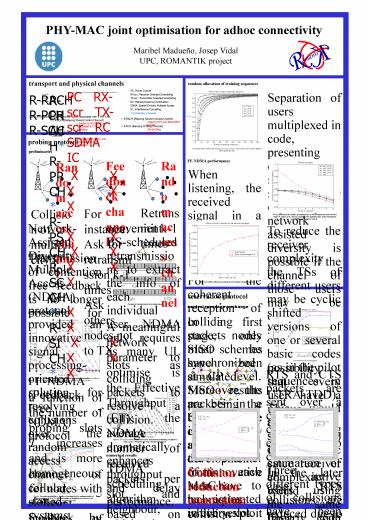ROMANTIK poster PowerPoint PPT Presentation
1 / 1
Title: ROMANTIK poster
1
PHY-MAC joint optimisation for adhoc connectivity
Maribel Madueño, Josep VidalUPC, ROMANTIK project
transport and physical channels
probing protocol
FF-NDMA performance
When listening, the received signal in a
contention period is combined. For the coherent
reception of colliding packets nodes must be
synchronized at CP level. Moreover, the packets
in a CP have to be identified uniquely and the
channel from each user have to be estimated in
every slot. A network with 1000 nodes has been
simulated, where the most connected node has 9
neighbours. It can be observed in the figure on
the right that the number of TSs (allocated at
random) not to degrade performance is small.
reservation protocol
control message exchange
protocol optimisation
In a first stage, only SISO schemes have been
simulated. SISO results are being the base for
the current study and development of innovative
MAC techniques which exploit MIMO configurations
suitably. The performance of the reservation
protocol adapted for multi-hop operation in UMTS
TDD is presented. The figure illustrates the
RTS/CTS basic message exchange throughput using
different physical layer schemes (scr
user-oriented scrambling, PC power control).
A meaningful network parameter to optimise is the
Effective Throughput (ET) the average number of
received packets per slot and neighbour, which is
a function of a, R and the number of neighbours
N. In a heterogeneous network, where different
nodes may have different number of neighbours the
ET is optimised for the most connected nodes,
because they are in a more disadvantageous
situation. The optimum value of R for the ET
increases with N, since more slots in a CP are
desired to demodulate more users, but at a lower
rate than N because not all neighbours will be
able to transmit during the CP. When
retransmission combining is used (Rgt1) the
probability of receiving a packet of any
neighbour as
- RTS and CTS packets are sent over a contention
channel being exposed to collisions. Three
different types of collisions have been
identified - unavailability collisions the receiving node is
already transmitting, - direct collisions the receiving node is the
intended destination of more than one
transmitter, - and non direct collisions the receiving node
is interfered by a third node.
Unavailability
Direct
a function of the number of probing slots T
increases and is more homogeneous for nodes with
different number of nodes than when R1. In
each group of curves in the figure below, the
optimum value of a is selected. When R1 the most
connected nodes actualising their probing
information every 14 (30) slots, only have a
probability of 81 (89) of being received, while
for R3 (the optimum value for the most connected
node) those probabilities are of the 95 (99).
The immediate conclusion is that the access delay
is reduced and that retransmission combination
allows higher dynamic topology changes.
In the later case, RTS collisions are reduced due
to the PHY layer techniques but increased due to
the CTS collisions.
Collision reduction constraint collision
reduction of both RTS and CTS packets must be of
the same order. Not all collisions are equally
likely and harmful. Percentage of occurrence of
different collision types is shown when using the
last two physical layer schemes in the preceding
figure. Unavailability collisions are the most
critical.

